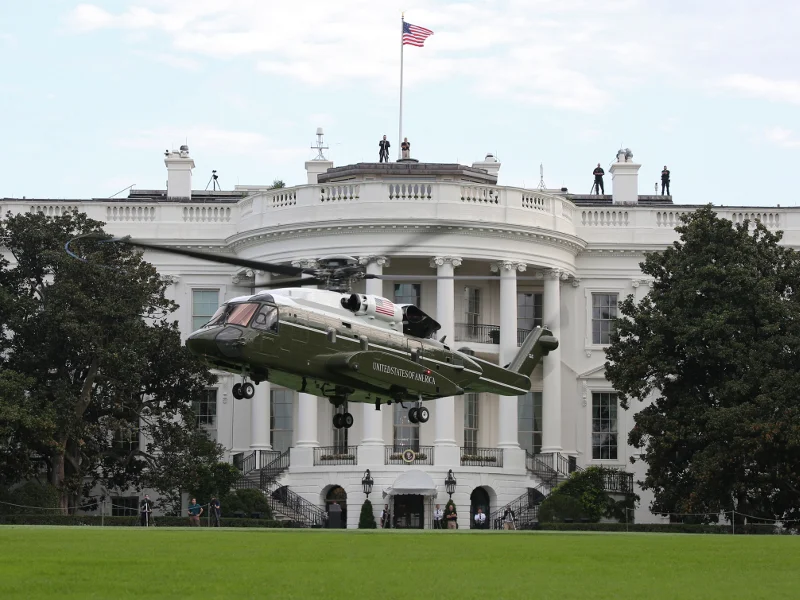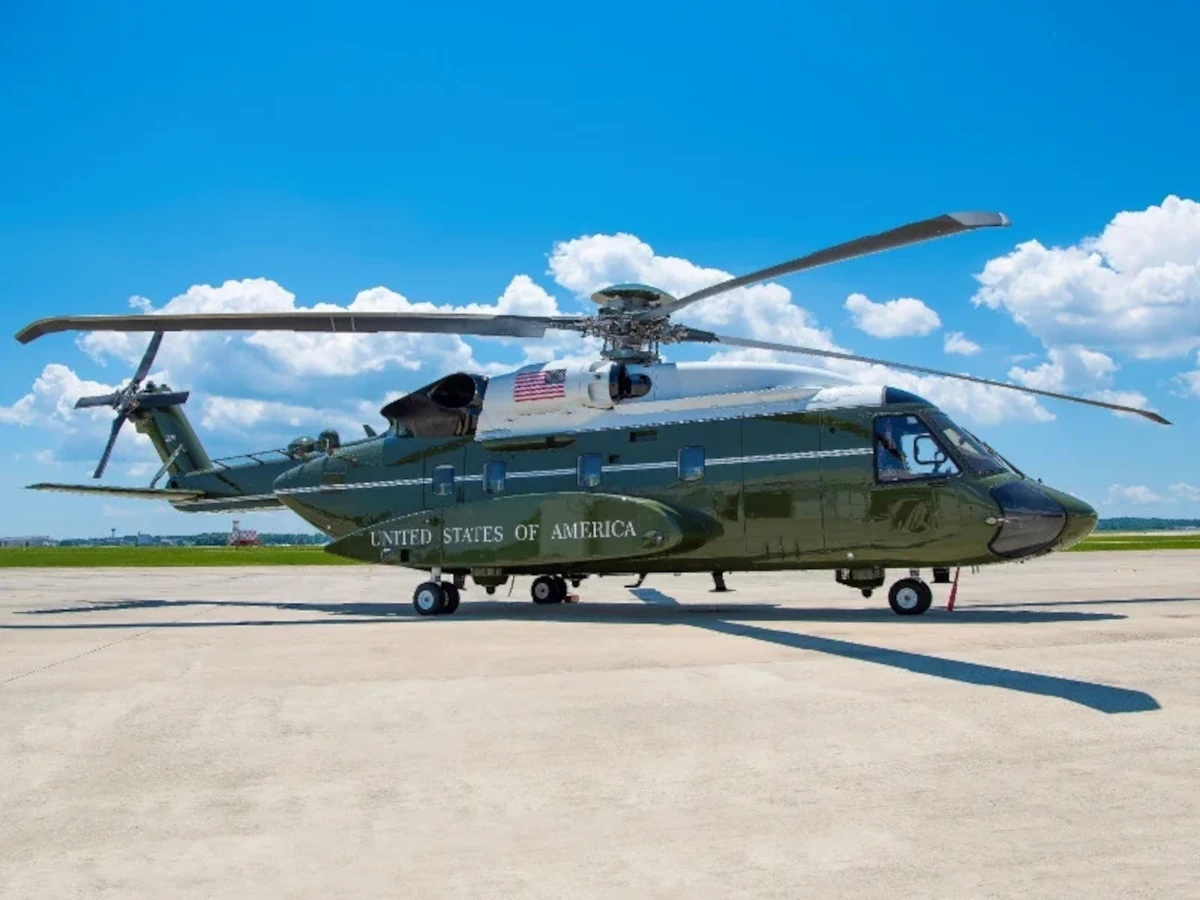The U.S. Presidential helicopter, known as Marine One when the President is on board, is a symbol of American military precision and engineering excellence.
For decades, the VH-3D Sea King and VH-60N White Hawk served as the primary helicopters for the U.S. President.
However, as technology advanced and operational requirements evolved. A new generation of aircraft was needed to meet the demands of modern-day presidential transport. Enter the Sikorsky VH-92A Patriot.

The Legacy of the VH-3D Sea Kings and VH-60N White Hawks
Service Life and Historical Impact
The VH-3D Sea King, first introduced in 1978, and the VH-60N White Hawk, introduced in 1988, have been the backbone of Marine Helicopter Squadron One (HMX-1) for decades.
The Sea Kings, having been converted from earlier models, carried the weight of the U.S. presidency through the Cold War, the post-9/11 era, and into the 21st century.
Despite their robust design and reliability, the wear and tear of decades of service began to show, necessitating a new aircraft to carry the mantle.
Operational Limitations
The aging fleet faced numerous challenges. The VH-3D, while reliable, required significant maintenance and had limitations in terms of transportability.
For instance, the helicopter’s rotor blades had to be removed for transport in C-17 Globemaster III cargo aircraft, which required the C-17 to have a minimal fuel load to ensure clearance during loading and unloading.
Similarly, the VH-60N, though smaller and easier to transport, lacked the capacity and advanced features necessary for modern presidential transport.
The Arrival of the VH-92A Patriot: A New Era of Presidential Transport
Development Timeline and Challenges
The VH-92A Patriot’s development began in earnest after the cancellation of the VH-71 Kestrel, a project was originally intended to replace the Sea Kings and White Hawks.
The Kestrel, based on the AW101 Merlin helicopter and backed by Lockheed Martin, was scrapped in 2009 due to rising costs, with nine airframes eventually being sold to Canada.
Sikorsky’s S-92 platform was then selected as the basis for the VH-92A in 2014, after being the only bid submitted in the restarted VXX Presidential Helicopter Replacement Program.
Despite this, the development of the VH-92A was not without its hurdles.
Initial flights in 2017 were promising, but issues with reliability, maintenance, and its impact on grass landing sites delayed the program’s progress.
Technological Advancements and Features
The VH-92A represents a significant leap forward in technology compared to its predecessors.
Equipped with modern avionics, enhanced communications systems, and advanced defensive measures, the VH-92A is designed to ensure the safety and efficiency of the President’s travels.
The helicopter also features a more spacious and comfortable interior, improved aerodynamics, and better fuel efficiency.
One of the key technological improvements is the VH-92A’s avionics suite, integrates the latest in navigation and communication systems, ensuring secure and reliable connectivity for the President at all times.
Additionally, the VH-92A’s defensive systems are state-of-the-art, providing advanced protection against potential threats.

The Road to Full Operational Capability
Initial Operating Capability (IOC) and Deployment
The VH-92A reached Initial Operating Capability (IOC) in December 2021, marking a critical milestone in its journey to becoming Marine One.
However, despite achieving IOC, the helicopter faced continued scrutiny and testing to address issues related to its availability and reliability.
Reports indicated the VH-92A had limited operational deployment due to concerns about its maintenance needs and performance in emergency situations.
In response, the U.S. Marine Corps and Sikorsky undertook additional testing and modifications to ensure the aircraft met the rigorous standards required for presidential transport.
These efforts culminated in the delivery of the final VH-92A to HMX-1 on August 14, 2024, signifying the beginning of the end for the VH-3D Sea Kings and VH-60N White Hawks.
First Operational Flight: A Historic Moment
President Joe Biden’s use of the VH-92A Patriot as Marine One on August 19, 2024, marked a historic moment in the helicopter’s operational history.
After stepping off Air Force One at Chicago O’Hare International Airport, President Biden boarded the VH-92A (serial number 169186) for a flight to Soldier Field, demonstrating the helicopter’s readiness to serve as the primary presidential transport.
The Future of Marine One: Transitioning to the VH-92A Fleet
Replacement of the Legacy Fleet
The U.S. Marine Corps has planned a phased transition from the VH-3D and VH-60N helicopters to the VH-92A fleet.
As of now, 21 VH-92A airframes will be part of the operational fleet, with two additional helicopters designated as test airframes.
The VH-3D Sea Kings, with over 40 years of service, will gradually be retired as the VH-92A becomes fully operational.
Impact on Presidential Transport Operations
The transition to the VH-92A is expected to enhance the operational capabilities of HMX-1. The new helicopters offer improved performance, greater reliability, and the ability to operate in more diverse environments.
This is particularly important for presidential missions require landing in remote or unprepared locations, a capability was somewhat limited with the older helicopters.
However, the transition process is expected to take time.
The legacy fleet of VH-3D and VH-60N helicopters will likely continue to operate in tandem with the VH-92A until the new helicopter is fully integrated into the fleet.
This phased approach ensuresthere is no gap in presidential transport capabilities during the transition period.
Challenges and Considerations Moving Forward
Operational Readiness and Maintenance
One of the primary challenges for the VH-92A fleet will be maintaining operational readiness.
The helicopter’s advanced systems, while offering significant benefits, also require specialized maintenance and support. T
The VH-92A fleet remains mission-ready at all times will be a critical focus for HMX-1 and Sikorsky.
Public Perception and Media Scrutiny
As with any high-profile military program, the VH-92A will continue to face scrutiny from the media and public.
Issues such as the helicopter’s impact on grass landing sites and its initial reliability concerns have already garnered attention.
Moving forward, the U.S. Marine Corps and Sikorsky will need to manage public perception and address any emerging concerns proactively.
The Strategic Importance of Marine One
The VH-92A’s role as Marine One goes beyond mere transportation.
It is a symbol of American power and technological prowess, and its reliability and performance are of strategic importance.
The helicopter must be able to perform flawlessly in a variety of scenarios, from routine flights to emergency evacuations.
As such, the continued development and improvement of the VH-92A will be essential.
Conclusion: The VH-92A Patriot in the Annals of Marine One History
The transition from the VH-3D Sea Kings and VH-60N White Hawks to the VH-92A Patriot represents a new chapter in the history of Marine One.
While the road to operational readiness has been long and challenging, the VH-92A is now poised to serve as the primary helicopter for the U.S. President.
With its advanced technology, improved performance, and greater reliability, the VH-92A is set to carry the legacy of Marine One into the future.
As the VH-92A fleet becomes fully operational, it will continue to be a symbol of American strength and resilience.
The lessons learned during its development and deployment will serve as valuable knowledge for future generations of presidential transport aircraft. Ensuring Marine One remains a vital asset for the U.S. government for decades to come.


































